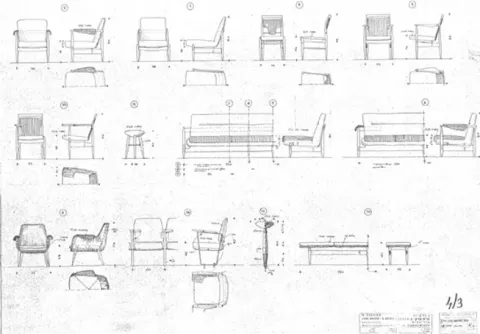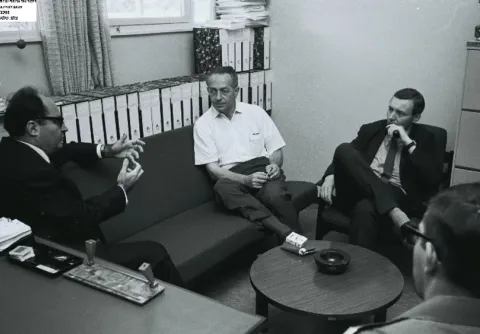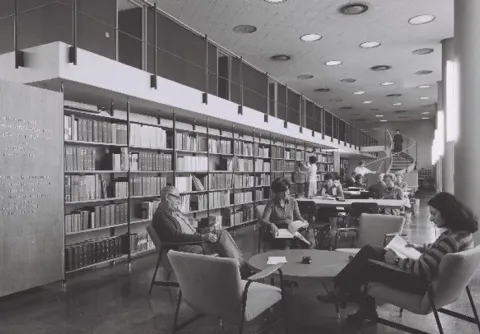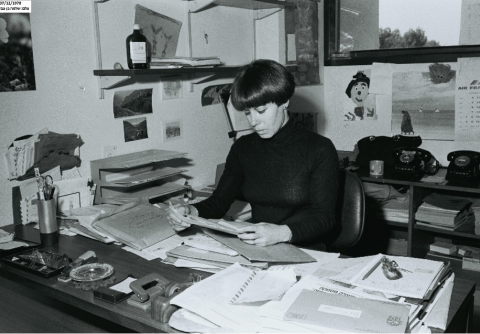About us
In the recent years, we have witnessed a change in the design of our working environments, resulting from the trend of blurred boundaries between “the office” and other spaces.
Being at the office every day is no longer imperative nowadays, especially as some work-related tasks can be completed from a laptop, anywhere. This has given rise to physical changes in the planning and design of the contemporary office space: Work areas are undergoing a transformation, from introspective offices into open spaces, which facilitate direct connections between colleagues through conversations, meetings, collaborations, and informal gatherings.
This website presents different workspace alternatives for private offices and public areas, which were designed and implemented by the Construction and Engineering Division. These recently completed projects reflect the diversity of our work environments.
The website was created to serve as a tool for those planning renovations or redesign, providing a view of the range of styles and designs, as part of the design process carried out jointly by the Construction and Engineering Division and its clients at the Institute.
In the ever-changing world of design, this website will constitute a dynamic catalog of designs ideas, which will be updated and refreshed periodically.
Dan Slonim
Head of the Construction and Engineering Division
Sharon Gloter
Institute Architect
Head of physical Planning Branch
History | A Look into the Past
Buildings constructed on campus between the 1930s and the 1960s represent the finest Israeli architecture designed by Eretz Israel’s leading architects of the time.[1] The buildings and landscape were designed in the spirit of architectural excellence that was part and parcel of the vision of Weizmann and Weisgal, to design a work environment perfect in every respect. Some of these buildings were designed to the very last detail of the building’s interior.
Of the buildings, 24 were recently designated as preservation sites. Most have kept their facades as originally designed, but their interior and all other elements of internal design (carpets, curtains, wallpaper, lighting fixtures, carpentry and furniture items) were refurbished and renewed time and again during the building’s existence.
The building’s changing interior design, remodeled to suit emerging scientific needs and technologies, reflect shifting design fashions and styles, alterations in the building’s purposes, and employee and user turnover over the years. An examination of the original building plans reveals the details of the early buildings’ initial interior design. For instance, the detailed furniture and woodwork plans for the Wix Library, designed in 1953 by architects Arieh Sharon, Nahum Zalkind, and Benjamin Idelson.
Architect Arieh Sharon[2], who was educated at the Bauhaus School in Berlin, designed the building’s full set of furniture elements, including the lighting fixtures, door handles, cabinet metal fixtures, auditorium chairs, lectern, screen, water trolley, telephone stand, and even the signage in the auditorium and rooms. To Sharon, the Bauhaus graduate, the building was perceived as a complete and harmonious “work” that includes not only an architectural envelope, but also an elaborate consideration of the details that were built to fully fit the space and architect’s vision. Other campus structures designed by Sharon – the Weissman Building (1957) and the San Martin Faculty Clubhouse (1954) – similarly manifest his characteristic style and nature of his work as the building’s “super planner” in both outdoor and indoor details.
[1] Including Erich Mendelsohn, Benjamin Chaikin, Arieh Elhanani, Nahum Zalkind, Arieh Sharon, Benjamin Idelson, Yakov Rechter, Israel Dicker, and others
[2] Arieh Sharon, 1900-1980: An Israeli architect, winner of the Rokach Prize for Architecture and the Israel Prize for Architecture in 1962. Born in Jaroslau, Poland. In 1926, he travelled to study architecture at the Bauhaus in Dessau, Germany, under Walter Gropius and Hannes Meyer. Completing his studies in 1929, he remained in Berlin to work as chief architect in the architectural office of his teacher, Hannes Meyer, until 1931. He returned to Israel at the beginning of 1932 and opened a private practice in Tel Aviv, bringing the spirit of Bauhaus architecture to the city. Architecture for him was not an end but a means through which to provide citizens with quality of life and establish a new social order. He worked chiefly for the public sector. In pre-State Israel, his activity focused mainly on planning housing estates, known as Meonot Ovdim in Hebrew, laborer neighborhoods, cinemas, hospitals, institutions, and a small number of residential buildings.

Perspective of the interior design in the Charles Clore International House
Design: Architect Arieh Elhanani, 1963

The chairs and sofas specifications in the Wix Auditorium project, which was an integral part of the building’s design plan.
Design: Architects Nahum Zalkind, Arieh Sharon, and Benjamin Idelson
Dr. Chaim Weizmann’s house, designed in 1935 by architect Erich Mendelsohn, presents the same holistic planning approach.
Mendelsohn planned the interior design details of the house, as well as those of the garden around it, as he saw himself fully responsible for interior details, including furniture, textiles, lighting fixtures, etc.
In contrast to the decorative, creative, and influential style of 1930s design, and the total architecture of the Institute’s early public buildings, most of the work and meeting spaces constructed on campus from the end of the 1950s onwards echoed the economic austerity (“tzenah”) style prevalent in Israel at the time. In the State’s early years, one central theme was prominent in the Israeli style: Austerity. No superfluous decoration, no far-reaching design ambitions, and little diversity.
The local furniture industry, mainly “Shomrat Hazorea”, provided classic, simple, and durable products. Photographs taken in those years show furniture with characteristic minimalist lines, slightly curved or bent, bordering on asceticism.
In the 1970s and 1980s, interior room and furniture design in campus buildings remained mostly unchanged. Some of the furniture items from those years can still be found in offices of the Institute’s scientists and employees.
In general, it can be said that the design of work environments in Israel and abroad until the end of the 20th century was characterized mainly by practicality and economy, concentrating on work space functionality.
This trend is beginning to shift, with the technological changes of the 21st century, which enable working almost anywhere, not necessarily at the office desk.
Accordingly, we are now witnessing a revolution in the design of our work environments, which must also serve as a place to meet others, interact with colleagues, and provide a pleasant setting.

A scientist’s room from the 1960s

Meeting in a scientist’s office from the 1960s, around a round Formica table

Taking a coffee break in the Stone Administration Building, the 1960s

Wix Library reading hall, the 1960s

A 1970s office
